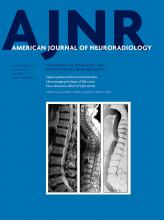Index by author
Tuilier, T.
- LetterYou have accessReply:J. Hodel, E. Kalsoum, T. Tuilier, A. Benaïssa, R. Blanc and P. BrugièresAmerican Journal of Neuroradiology November 2018, 39 (11) E119; DOI: https://doi.org/10.3174/ajnr.A5789
Turski, P.
- LetterYou have accessComment on “Blood Flow Mimicking Aneurysmal Wall Enhancement: A Diagnostic Pitfall of Vessel Wall MRI Using the Postcontrast 3D Turbo Spin-Echo MR Imaging Sequence”M. Edjlali, P. Turski, C. Oppenheim and O. NaggaraAmerican Journal of Neuroradiology November 2018, 39 (11) E118; DOI: https://doi.org/10.3174/ajnr.A5777
Tymofiyeva, O.
- EDITOR'S CHOICEPediatric NeuroimagingOpen AccessAberrant Structural Brain Connectivity in Adolescents with Attentional Problems Who Were Born PrematurelyO. Tymofiyeva, D. Gano, R.J. Trevino, H.C. Glass, T. Flynn, S.M. Lundy, P.S. McQuillen, D.M. Ferriero, A.J. Barkovich and D. XuAmerican Journal of Neuroradiology November 2018, 39 (11) 2140-2147; DOI: https://doi.org/10.3174/ajnr.A5834
The purpose of this study was to identify the neural correlates of attentional problems in adolescents born prematurely and determine neonatal predictors of those neural correlates and attention problems. Of the 24 subjects, 12 had attention deficits. A set of axonal pathways connecting the frontal, parietal, temporal, and occipital lobes had significantly lower fractional anisotropy in subjects with attentional problems. The temporoparietal connection between the left precuneus and left middle temporal gyrus was the most significantly underconnected interlobar axonal pathway. Low birth weight and ventriculomegaly, but not white matter injury or intraventricular hemorrhage on neonatal MR imaging, predicted temporoparietal hypoconnectivity in adolescence.








